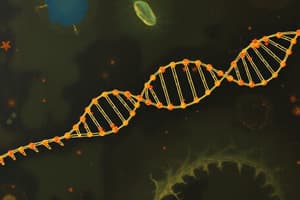Podcast
Questions and Answers
What is the role of DNA ligase in DNA replication?
What is the role of DNA ligase in DNA replication?
- Creates Okazaki fragments on the lagging strand
- Seals the gaps between Okazaki fragments on the lagging strand (correct)
- Synthesizes RNA primers for DNA replication
- Moves in the 3' to 5' direction during DNA replication
Which enzyme is responsible for synthesizing Okazaki fragments during DNA replication?
Which enzyme is responsible for synthesizing Okazaki fragments during DNA replication?
- DNA helicase
- DNA polymerase (correct)
- DNA ligase
- RNA primase
Why does DNA polymerase synthesize Okazaki fragments on the lagging strand?
Why does DNA polymerase synthesize Okazaki fragments on the lagging strand?
- It follows the same direction as leading strand synthesis
- It can only move in the 3' to 5' direction (correct)
- It helps in forming the RNA primers
- It aids in DNA repair processes
Where do replication forks initiate on the chromosome in most prokaryotes?
Where do replication forks initiate on the chromosome in most prokaryotes?
What process allows for multiple replication origins to exist simultaneously within a single prokaryotic chromosome?
What process allows for multiple replication origins to exist simultaneously within a single prokaryotic chromosome?
Which enzyme catalyzes the formation of phosphodiester bonds between adjacent Okazaki fragments?
Which enzyme catalyzes the formation of phosphodiester bonds between adjacent Okazaki fragments?
What is the role of DNA polymerase III in prokaryotic cells?
What is the role of DNA polymerase III in prokaryotic cells?
Which enzyme adds nucleotides onto growing chains during semiconservative replication?
Which enzyme adds nucleotides onto growing chains during semiconservative replication?
Where does the process of DNA replication begin?
Where does the process of DNA replication begin?
Which direction does the initial polymerization step occur during leading strand synthesis?
Which direction does the initial polymerization step occur during leading strand synthesis?
What is the main function of DNA polymerase IV in prokaryotic cells?
What is the main function of DNA polymerase IV in prokaryotic cells?
What is the purpose of a small RNA primer in DNA replication?
What is the purpose of a small RNA primer in DNA replication?
Flashcards are hidden until you start studying
Study Notes
DNA Replication in Prokaryotes
Prokaryotic cells do not have a nucleus or membrane-bound organelles like their eukaryotic counterparts. Instead, they rely on a smaller, streamlined set of processes that occur within the cytoplasm, including DNA replication. This process is responsible for creating exact copies of each chromosome before cell division occurs. Here's how it all works:
DNA Polymerase
DNA polymerases are enzymes that play a crucial role in DNA replication. They add nucleotides onto growing chains during semiconservative replication, which means that new strands are complementary to existing ones. In prokaryotes, there are two main types of DNA polymerases: I and III. While type II is involved in proofreading, repair of errors, and other processes, type III is primarily dedicated to DNA replication. Additionally, DNA polymerase IV also performs recombination and repair functions, while DNA polymerase V has multiple roles, including error correction and genomic maintenance.
Leading Strand Synthesis
The process of DNA replication begins with a small RNA primer binding to the template strand at an origin site called the replication fork. Then, the replication machinery moves along the parental strand, adding nucleotides to create a new strand. Because this initial step involves polymerization only in the 5' to 3' direction, it's referred to as the leading strand.
Lagging Strand Synthesis
Once the replication fork passes, another RNA primer binds to the newly formed single-stranded region of the template strand and acts as a starting point for the lagging strand synthesis. However, unlike the leading strand synthesis, DNA polymerase can only move in the 5' to 3' direction, so it synthesizes Okazaki fragments in the opposite direction. These short segments need to be connected by DNA ligase to form a complete strand.
DNA Ligase
One essential factor in DNA replication is DNA ligase. It seals the gaps between the Okazaki fragments created during the lagging strand synthesis. By catalyzing the formation of phosphodiester bonds between the termini of adjacent Okazaki fragments, DNA ligase ensures the continuity of both strands.
Replication Origin
In most prokaryotes, there is no specific site for DNA replication initiation called an origin of replication or centromere. Instead, replication forks can initiate anywhere on the chromosome where RNA primers bind to a suitable template strand. This process is known as replicative transposition and allows multiple replication origins to exist simultaneously within a single chromosome. As a result, prokaryotes have a higher number of potential DNA replication sites compared to eukaryotic cells with specific origins.
Studying That Suits You
Use AI to generate personalized quizzes and flashcards to suit your learning preferences.




